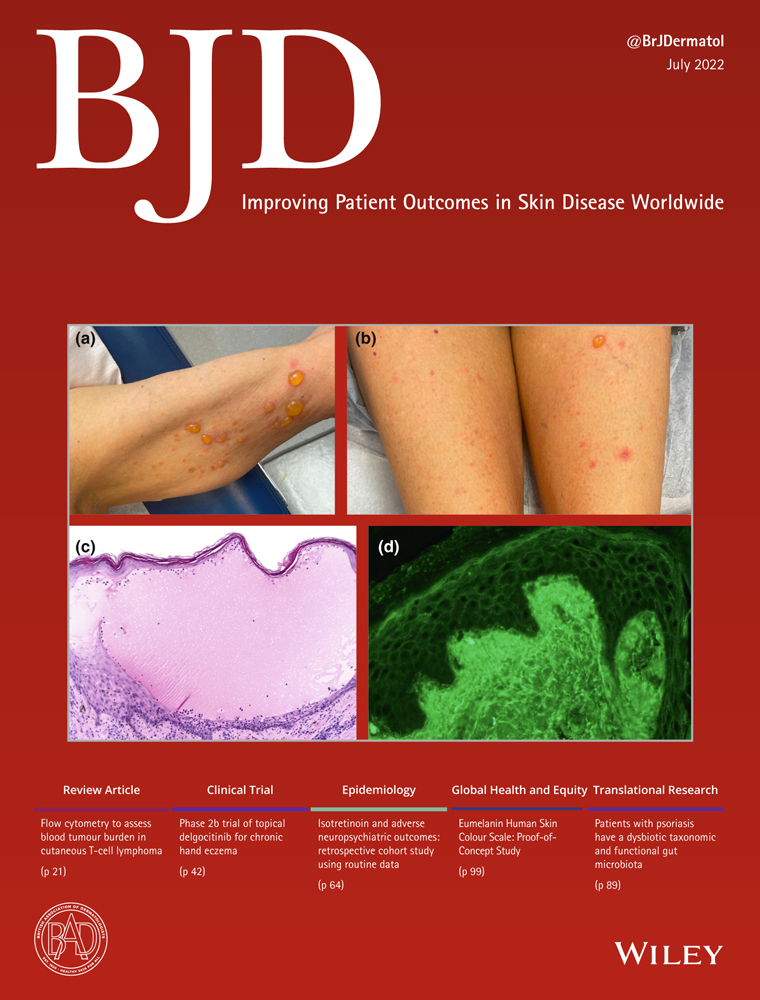Survival from cutaneous malignant melanoma is improving, but is it because of a trend in decreasing melanoma thickness or the advent of new ‘revolutionary’ therapeutics?
Conflicts of interest: the authors declare they have no conflicts of interest.
Abstract
Linked Article: Zamagni et al. Br J Dermatol 2022; 187:52–63.
In this issue of the BJD, Zamagni et al.1 present their findings of an increase in net survival from cutaneous malignant melanoma (CMM) in Italy (2003–2017). Previously, the improved survival has been thought to result from the decreasing trend in tumour thickness over time.2, 3 Although the incidence of CMM has been increasing in all Western countries, owing to increased exposure to solar or artificial ultraviolet radiation, the increase may, in part, be because of overscreening, overbiopsying and falling pathological thresholds for melanoma, boosted by increased public awareness about seeking skin checks, which has resulted in an additional ‘statistical’ rise in thin melanomas or melanoma in situ·3–5 There can also be considerable regional variation within or between countries with regard to melanoma mortality and incidence.2, 6 Another possibility that might explain the improved survival is the advent of targeted therapies with BRAF/MEK inhibitors and immune checkpoint blockade for the treatment of metastatic melanoma about a decade ago,7 although their contribution to 5-year survival has been poorly defined at the population level.
In their study, Zamagni et al.1 performed an analysis of CMM registered in patients between 2003 and 2017 in 11 local cancer registries covering a population of 8 056 608 (13·4% of the Italian population in 2010). By using sophisticated statistical analyses, the authors calculated the age-standardized 5-year net survival, the relative excess risk (RER) of death and the relative contribution of the decrease in tumour thickness to the RER. The purpose was to compare CMM data at 5-year intervals in 2013–2017, 2008–2012 and 2003–2007. The authors found, indeed, that tumour thickness was inversely associated with 5-year net survival and RER in both sexes. However, male patients reached the same level of survival as female patients in 2013–2017 despite still having thicker melanomas. Furthermore, the trend in thickness decrease explains less than 20% of the survival improvement in 2013–2017, especially so in male patients, but the advent of new melanoma therapies in 2013 most likely explains the rest. The results are in line with the first study reporting 1-year survival improvement in the USA during 2010–2013.8
Based on the findings of Zamagni et al.,1 one might raise the question of whether there is a place for costly melanoma screening programmes in order to find early-phase thin melanomas and, consequently, to reduce mortality.4 However, the investigators also report that the decrease in tumour thickness among male patients explains largely the survival improvement in patients diagnosed in 2008–2012 compared with those in 2003–2007, but not with those in 2013–2017.1 In addition, in the German melanoma screening programme (SCREEN) in Schleswig-Holstein in 2003–2004, total body examination in 360 288 individuals led to an almost 50% reduction in mortality as reported in 2012.9 Even though the justification for untargeted population-wide screening has been questioned,4 it should be remembered that there can be large variations within and between populations in different geographical regions. Targeted screening of defined risk groups and regular skin self-examination can still be recommended10 – together with the use of effective medication in metastatic melanoma.
Acknowledgments
the authors thank Professor Veli-Matti Kähäri (Department of Dermatology, University of Turku, Turku, Finland) for constructive criticism related to this commentary.
Author contributions
Ilkka T Harvima: Conceptualization (lead); formal analysis (equal); funding acquisition (lead); investigation (lead); writing – original draft (lead); writing – review and editing (equal). Rauno Juhani Harvima: Formal analysis (supporting); investigation (supporting); writing – review and editing (equal).




